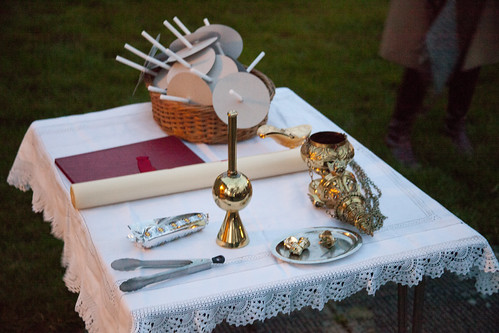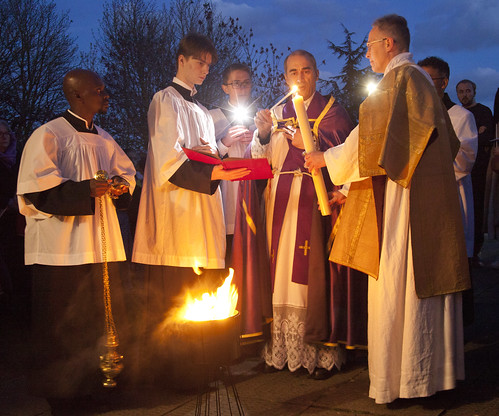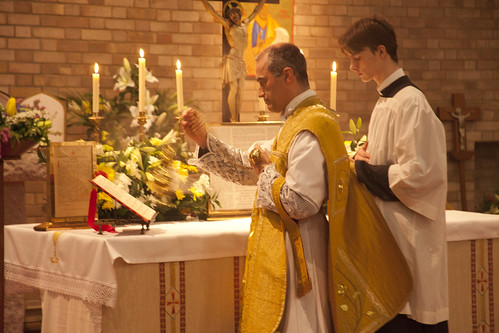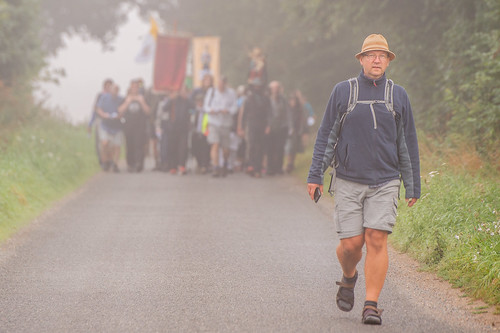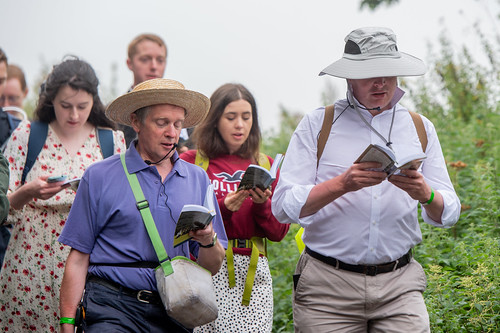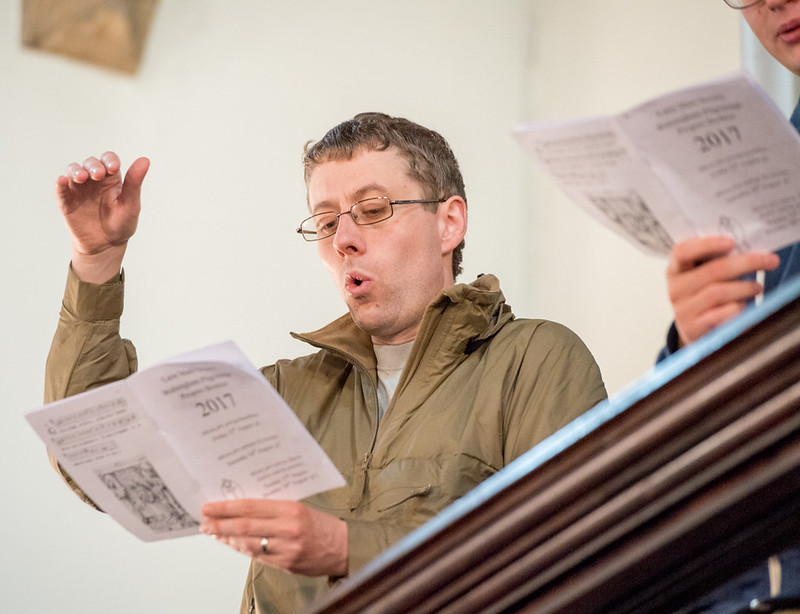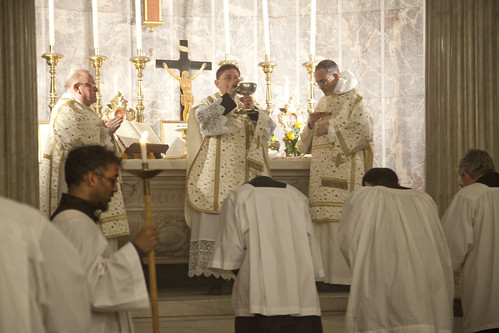Chairman's Blog
Traditional Triduum Services restricted: in the Catholic Herald
 |
| Easter Vigil at St Mary Moorfields in 2023 |
The liturgical celebrations of the Easter Triduum – spanning Maundy Thursday to Easter Sunday – according to the ancient (Traditional Latin) rite will not take place in the Diocese of Westminster this year.
The changes follows the decision of Cardinal Vincent Nichols, archbishop of the diocese, and the head of Catholics in England and Wales, to discontinue the custom of featuring liturgy over the Easter weekend in the traditional form – something which had taken place annually since the 1990s.
Cardinal Nichols acknowledged in correspondence to Fr Michael Cullinan denying the latter’s request to host this year’s triduum at St Mary Moorfields – the only Catholic church in The Square Mile of the City of London – that he was aware the decision would cause disappointment.
“I realise that this will disappoint some people,” he revealed, “but I have to keep the wider picture in view”, in an email which has been shown to the Herald.
Easter Vigil in Bedford: photos
Mass of the Ages film, Part 3: Guardians of Tradition
Walsingham Pilgrimage Volunteers needed, 5: First Aiders and photographers
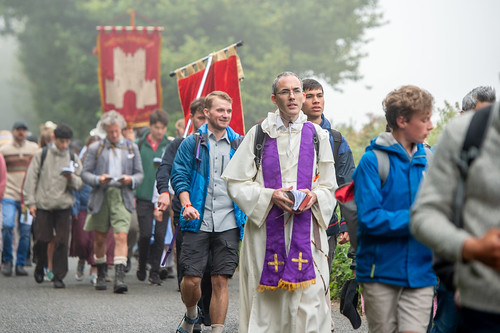 |
| A photo by a professional photographer, John Aron. See what he's done with the depth of field? |
Booking is now open for the LMS Walking Pilgrimage to Walsingham, which takes place from Thursday 22nd August to Sunday 25th August. But before we can welcome 200+ pilgrims, we need to be able to look after them. This is the last of these appeals, for two more categories of volunteers: First Aiders and photographers.
 |
| Taken by me. |
 |
| Another by John Aron. |
Walsingham Pilgrimage volunteers needed, 4: marshals and campsite volunteers
Booking is now open for the LMS Walking Pilgrimage to Walsingham, which takes place from Thursday 22nd August to Sunday 25th August. But before we can welcome 200+ pilgrims, we need to be able to look after them. Today I appeasing for two more categories of volunteers: marshals for the walking part of the pilgrimage, and volunteers to assemble and dismantle things like gazebos at the campsites.
Walsingham Pilgrimage volunteers wanted, 3: singers
Walsingham Pilgrimage Volunteers wanted 2: drivers
Walsingham Pilgrimage Volunteers needed, 1: cooks and cleaners
For whoever gives you a cup of water to drink in My name, because you belong to Christ, assuredly, I say to you, he will by no means lose his reward.
The cooking team is led by a professionally qualified cook, and the core team has many years' experience of cooking for the pilgrims in the unique conditions of the Walsingham Pilgrimage. They need help from a wider group of people who would like to participate in the pilgrimage in this special way, both in preparing meals and in preparing venues and cleaning them after the pilgrims have departed.
 |
| A concession to mechanisation. |
Westminster Diocese Triduum cancelled
Traditional Latin Easter Triduum Services
in the Archdiocese of Westminster cancelled
The Latin Mass Society is grieved to announce that the
Cardinal Archbishop of Westminster, Vincent Nichols, will not give permission
for the celebration of the major services of the Sacred Triduum (Maundy
Thursday, Good Friday, Holy Saturday) according to the liturgical books in use
before the Second Vatican Council: the Traditional Latin liturgy or Vetus
Ordo.
There has been a celebration of the Traditional
Triduum in the Archdiocese, with the permission of successive Archbishops,
since the 1990s: first in Corpus Christi Maiden Lane, and then in St Mary
Moorfields in the City of London. In recent years these services have been
attended by up to 200 people.
His Eminence places this decision in the context of
his ongoing dealings with the Dicastery for Divine Worship in Rome, writing ‘My
approach to these matters is to be within the parameters laid down by the Holy
See while waiting for the judgment of the Holy See on which, if any, parish
church may be used for the celebration of Mass according to the Missal
antecedent to the reform of 1970.’[1]
His decision, he explains, was made ‘for the sake of
the wider provision’.
Comment from the Latin Mass Society
The faithful attached to the Vetus Ordo, served
by Sunday celebrations in St James Spanish Place, the London Oratory, and other
locations, will now be denied the chance to attend the most important
liturgical days of the year according to this liturgy within the Archdiocese of
Westminster.
When Pope Francis’ Apostolic Letter Traditionis custodes,
which restricted the Vetus Ordo, was published in 2021, Cardinal Nichols
summarised the Holy Father’s concerns, adding: ‘In my judgement, these concerns
do not reflect the overall liturgical life of this diocese.’[2]
LMS Chairman Joseph Shaw comments: “In this decision,
as in the earlier ending of the 50-year tradition of two annual Vetus Ordo
Masses at the High Altar of Westminster Cathedral, and the 20-year practice of
the Archdiocese providing the Sacrament of Confirmation according to the Vetus
Ordo, it seems that Catholics attached to the older liturgy are being
punished for misdemeanours that Cardinal Nichols believes they have not
committed.
“We await with concern the decision of the Dicastery
of Divine Worship concerning the current celebrations of the Vetus Ordo on
Sundays and weekdays in the Archdiocese, which have enriched and consoled many
hundreds of Catholics over the decades. This form of the Mass never ceased to
be celebrated regularly in the Archdiocese, thanks to the pastoral solicitude
of Pope Paul VI in 1971, and of successive Archbishops, in allowing it to
continue. It is tragic to see that pastoral attitude now being put aside.
“At the same time, we can reassure Catholics attached
to the ancient Latin liturgy that the Triduum will still be celebrated in
London, outside Westminster Archdiocese, and that the Latin Mass Society will
continue to support these and other celebrations of this venerable liturgy.”
Notes for Editors
The Latin Mass Society was founded in 1965 to support
the continued celebration of the Catholic liturgy in the form it took at the
eve of the Second Vatican Council: the ‘1962 Missal’, the ‘antecedent Missal’,
the Vetus Ordo or Traditional Mass.
The Greater London area is served by three Catholic
dioceses: Westminster, Brentwood, and Southwark.
The “English Indult” granted by Pope Paul VI in 1971
allowed the Vetus Ordo to continue to be celebrated in England and Wales
without a break, even while it was prohibited in the rest of the world.
Services of the Easter Triduum began to be celebrated in
Corpus Christi Maiden Lane, Covent Garden, by the parish priest, Canon McDonald,
in the early 1990s; the full set of major services were celebrated from 1999. Ten
years later these moved to the larger church of St Mary Moorfields in the City
of London. They were not celebrated in 2021 due to COVID restrictions.
Latin Mass Society
Press contacts:
Communications Officer, Portia Berry-Kilby portia@lms.org.uk
Chairman, Joseph Shaw oxford@lms.org.uk
Registered Office: 9 Mallow Street, London EC1Y 8RQ
020 7404 7284
Registered Charity Number: 248388
[1]
In an email of 23rd
February to Fr Michael Cullinan, who was to have been the principle celebrant
of the Triduum services. Quoted with permission.
[2]
See the website of the Archdiocese
of Westminster
https://rcdow.org.uk/cardinal/news/cardinals-message-to-clergy-about-tra...

